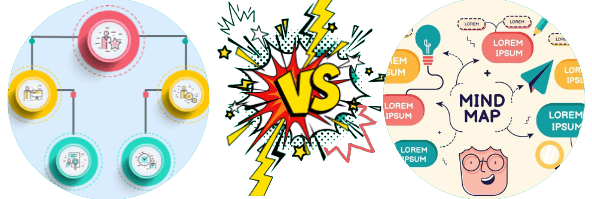You are not alone in thinking that concept and mind maps are the same. This confusion arises from their similar outlook and data structures. However, both these mapping techniques are different and serve distinct purposes.
Mind maps better organize ideas, whereas concept mapping focuses on connecting and analyzing concepts. Moreover, mind maps deal with one parent problem, which is not the case with interconnected ideas of concept maps. They may appear similar, but the creation process, readability, and comprehensibility of these two techniques differentiate them.
Concept map vs mind map: how are they different, and which is better? The only way to answer this question is by understanding their characteristics and application scope. So, let us dive in and learn more about their function.
In this article
What is a Concept Map
Joseph Novak, a researcher at Cornell University, developed concept maps in the 1970s to plot explicit changes in children’s cognition. He used several shapes (rectangles, circles, etc) to build relationships between elements on a blank canvas using a top-down hierarchy model.
The concept mapping technique illustrates a network of interdependent concepts. This is done by visualizing data structures logically and focusing on multiple parent-child topics. Unlike mind maps, these tools use factual information and crosslinks to identify solutions and take action.
Typically, concept maps are applied to complex real-life problems like decision-making, academic research, market analysis, and product development.
What is a Mind Map
Back in 1974, mind mapping was popularized by British TV presenter Tony Buzan. He used this technique for brainstorming and organizing information visually. Mind maps aid the human brain’s ability to store and process information hierarchy.
Typically, a mind map has a central idea with multiple sub-topics branching out through nodes, establishing a hierarchal structure. Each node has a different sub-topic, which can be individually expanded. Moreover, mind mapping is comparatively more personal, as it allows adding supplementary information.
Mind mapping is an excellent way to organize and interpret information clearly. Therefore, it is a great substitute for summarization, note-taking, and memorization.
Similarities and Differences Between Concept Maps and Mind Maps
Both mind mapping and concept mapping have individual narratives, which offer technical supports for their utilization. The two terms like this have precise meanings, anyway real or probable the cases behind them may be.
Mind maps are subjective, and clients are explicitly advised to "build up your very own style of Mind Mapping." Concept maps are the target presentation of the sensible connections among related ideas and thoughts or occasions.
Mind maps help create procedures as a strategy for brainstorming. Concept maps have an institutional capacity and fill in as a technique for introducing information and evaluating students' comprehension of information.
The most obvious difference between concept and mind maps is how they display information. While mind maps are easily comprehendible with basic data structures, concept maps dig deeper and establish complex data structures. In essence, concept maps value interconnected topics, whereas mind maps focus primarily on the central topic.

However, their similar structure makes people confuse them. So, let us discuss what differentiates themes in detail.
| Central Maps | Mind Maps |
| Interconnected concepts | Organized sub-topics |
| Verifiable cause-effect relationships | Non-verifiable abstract ideas |
| Multiple child-parent data structures | Focuses on one central idea |
| High difficulty level | Low difficulty level |
| Logical data organization | Flexible data organization |
| Creation requires resources and skill | Creation is fast, spontaneous |
Advantages and Disadvantages
Concept map vs mind map: which technique is better? Their closely resembling structures make it puzzling for users to find the correct task substitute. However, a clear idea of their characteristics can help determine which technique is best for what. So, let us discuss their pros and cons in detail.
1. Concept Maps
- Suitable for real-life complex problems like academic research and market trends
- Represent tacit knowledge with top-down hierarchy and multiple cause-effect relationships.
- Clear communication between complex concepts with labeled connections
- Include factual, verifiable data, helping users with memory retention and content gap analysis
- Promotes brainstorming and logical thinking
- Easily get cluttered and visually unappealing with stuffed information
- Creating them requires resources, skill, and time
- Strict guidelines may not be suitable for team collaboration
- Complex data structures result in low readability score
2. Mind Maps
- It helps the human brain develop spatial awareness.
- It can be adjusted to academic and business problems.
- Easily understandable/ low learning curve
- Offers flexibility/ allows users to personalize the concepts
- Beneficial in note-taking, summarization, and memorization
- No linking phrases/ high uncertainty
- Not applicable to real-life problems
- Not suitable for deeper analysis
Which One to Use
Once you have established how both techniques are used, it is equally essential to learn where to apply them in routine life.
1. Concept Maps
Concept maps illustrate a network of interconnected ideas and concepts suitable for analysis, comparison, and contrast. Therefore, its multi-purpose structure proves useful across the board, from education to businesses and healthcare. Here are some common uses of concept maps in these industries.
- Education: Academic research, study guides, and planning complicated curriculum.
- Business: product development, evaluating risks in project implementation, and brainstorming for new launches.
- Healthcare: disease diagnosis, finding the right treatments, and comparing patient’s medical records.
2. Mind Maps
In comparison, mind maps have an easily understandable data structure. Therefore, they are best suited for organizing information and memorizing it. Like concept maps, they are widely used across industries. So, let us dive in to get a sneak peek into their routine use.
- Education: Note-taking, summarization, essay writing, and group assignments.
- Businesses:project planning, event planning, and breaking tasks into manageable milestones.
- Personal Life:planning a career path and identifying future goals.
FAQs
1. Are mind maps better at generating new ideas than concept maps?
Mind maps visualize and organize information in a hierarchical structure, whereas concept mapping helps analyze a network of interconnected concepts. Hence, a mind map might focus on topic generation and may not be the best solution for innovating new ideas.
2. Are mind maps only capable of showing one-to-many relationships?
No, mind maps can also illustrate many-to-many relationships due to their flexible data structures. Users can utilize labels and crosslinks to explore many-to-many associations. However, they are not detailed as concept mapping.
3. How do you make a mind map and concept map?
Making a mind map is straightforward. Just gather a team, draft a problem statement, and start brainstorming. As you progress, plot-relevant ideas. In contrast, concept maps demand skill and resources. It starts by drafting a problem, organizing information, interconnecting the data, and making assumptions.
4. Is a concept map the same as a brainstorming diagram or a mind map, true or false?
It is partially true. Both concept and mind mapping are used to brainstorm solutions to a problem. However, they have a different method of displaying data structures. A concept map associates multiple concepts, whereas mind maps focus on one parent problem.
Conclusion
Mind map vs concept map: do you need to choose one? Well, yes. Though each technique has numerous benefits in professional and personal life, it is essential to know when to use which method. It is only possible when you clearly understand their data structures, contrasting characteristics, and use cases.
Integrating them into your daily life is a better way to approach it. Making each map once or twice can help understand how they are beneficial when used effectively. So, go ahead and start with mind maps. Once mastered, you can always switch to more complex concept mapping.




